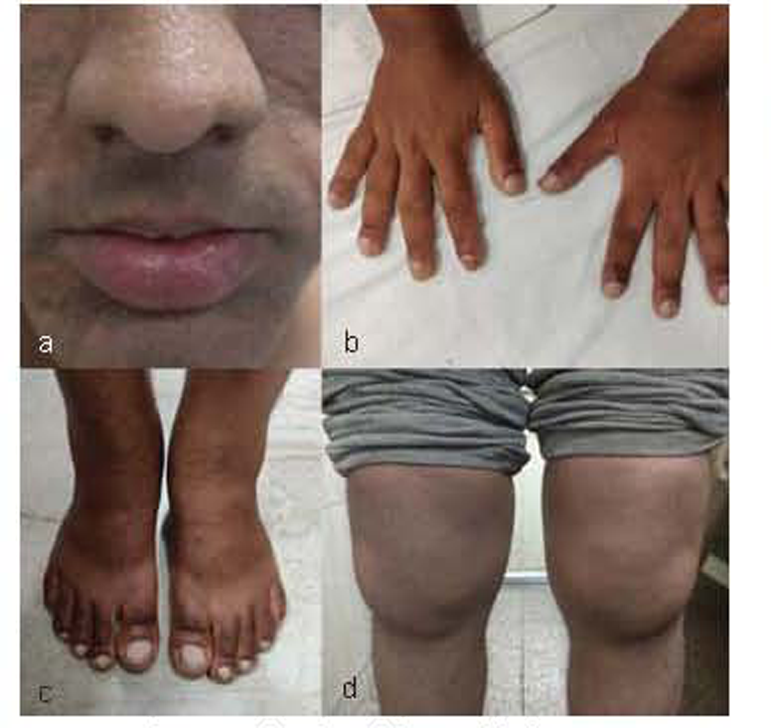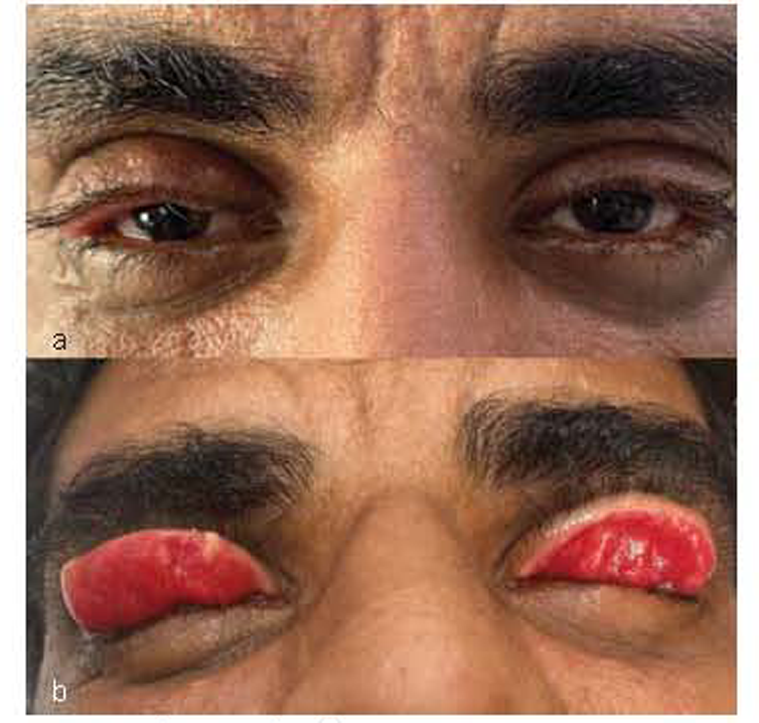Translate this page into:
Touraine–Solente–Gole syndrome: The elephant skin disease
Dr Rajendra Prasad Centre for Ophthalmic Sciences, All India Institute of Medical Sciences, New Delhi 110029, India doc.deep.das@gmail.com
[To cite: Agrawal S, Balakrishnan N, Modaboyina S, Thangavel R, Das D, Gupta S. Touraine–Solente–Gole syndrome: The elephant skin disease. Natl Med J India 2023;36:56–7. DOI: 10.25259/NMJI_629_20]
Pachydermoperiostosis (Touraine–Solente–Gole syndrome) is a rare genetic disease, with multiple systemic manifestations involving hypertrophic skin changes, digital clubbing and periostosis.1 A 23-year-old man presented with a history of thickening and drooping of his eyelids for the past 3 years. He complained of repeated swelling of his hip, knee and wrist joints. On examination, he had thickened, wrinkled facial skin with furrowing. There were deepened nasolabial folds and seborrheic hyperplasia (Fig. 1a). There was evidence of clubbing in the fingers (Fig. 1b) and toes (Fig. 1c) along with hyperhidrosis of the palm and sole. The knee joints also appeared swollen (Fig. 1d). There was diffuse thickening of the tarsus and lid margin with two small chalazions near the right lower lid margin with moderate ptosis in both eyes (Fig. 2a). Congestion and palpebral conjunctival hyperplasia were noted bilaterally (Fig. 2b). Technetium-99m bone scan showed symmetrical diffusely increased uptake in long bones of the appendicular skeleton and the periarticular region (Fig. 3). A diagnosis of pachydermoperiostosis was made. He was managed with intralesional injection of triamcinolone acetonide for chalazion, and topical antihistamine and lubricants for ocular irritation.

- Changes in the skin and joints

- Changes in the eyes

- Technetium-99m bone scan showing symmetrical diffuse uptake in the long bones
The disease has an estimated prevalence of 0.16% with onset in adolescence.2,3 The man:woman ratio is 7:1, with men being severely affected.4 It has autosomal dominant inheritance.5 Three clinical forms are described: complete (periostosis and pachydermia), incomplete (periostosis without pachydermia), and forme fruste (pachydermia with minimal periosteal change). While the typical course of the disease is self-limiting, non-steroidal anti-inflammatory drugs may be given to manage pain.6 To control the cutaneous manifestations, steroids, isotretinoin7 and botulinum toxin8 have been tried.
Conflicts of interest
None declared
References
- Massive eyelid thickening in pachydermoperiostosis with myelofibrosis. Ophthalmic Plast Reconstr Surg. 2009;25:316-18.
- [CrossRef] [PubMed] [Google Scholar]
- Epidemiology of hypertrophic osteoarthropathy. Clin Exp Rheumatol. 1992;10(Suppl 7):13.
- [Google Scholar]
- Familial idiopathic hypertrophic osteoarthropathy and cranial suture defects in children. Skeletal Radiol. 1982;8:105-9.
- [CrossRef] [PubMed] [Google Scholar]
- Touraine Solente Gole syndrome: The elephant skin disease. Indian J Plast Surg. 2013;46:577-80.
- [CrossRef] [PubMed] [Google Scholar]
- Miscellaneous non-inflammatory musculoskeletal conditions. Pachydermoperiostosis. Best Pract Res Clin Rheumatol. 2011;25:727-34.
- [CrossRef] [PubMed] [Google Scholar]
- Cutis verticis gyrata et pachydermopériostose. Plusieurs cas dans une même famille, Résultats préliminaires du traitement de la pachydermia avec l'isotrétinoïne [Cutis verticis gyrata and pachydermoperiostosis. Several cases in a same family. Initial results of the treatment of pachyderma with isotretinoin] Ann Dermatol Venereol. 1994;121:134-7.
- [Google Scholar]
- Treatment of pachydermoperiostosis pachydermia with botulinum toxin type A. J Am Acad Dermatol. 2010;63:1036-41.
- [CrossRef] [PubMed] [Google Scholar]




